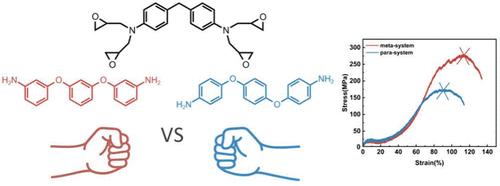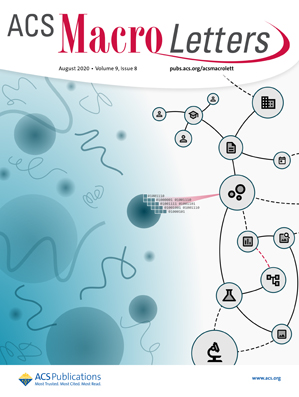Positional Isomerism Controls Epoxy Network Mechanics: Meta-Substitution Enhances Toughness via Adaptive Loop Dynamics from Multiscale Simulations
IF 5.2
Q1 POLYMER SCIENCE
引用次数: 0
Abstract
Positional isomerism is a key determinant of mechanical performance in polymer networks, yet its underlying molecular mechanisms remain insufficiently understood. In this work, we employ a multiscale simulation approach─integrating density functional theory with a stochastic coarse-grained reaction model─to investigate how meta- and para-substituted diamine curing agents influence the curing kinetics, network architecture, and mechanical properties of epoxy resins. Simulations reveal that the meta-substituted system exhibits higher ultimate strength and fracture toughness than its para-substituted counterpart, consistent with experimental observations. Mechanistic analysis shows that the enhanced performance of the meta-system stems from strain-induced conformational adaptation within loop structures, facilitated by progressive bond-angle relaxation. This dynamic response promotes energy dissipation and effectively suppresses void growth during deformation. In contrast, the para-system undergoes accelerated failure due to its restricted structural flexibility. Our findings highlight positional isomerism as a powerful molecular design strategy for achieving simultaneous improvements in strength and toughness in epoxy thermosets, providing a foundation for rational material design beyond empirical approaches.

位置异构控制环氧树脂网络力学:元取代通过自适应环动力学从多尺度模拟增强韧性
位置异构是聚合物网络中机械性能的关键决定因素,但其潜在的分子机制仍未得到充分的了解。在这项工作中,我们采用了一种多尺度模拟方法──将密度泛函理论与随机粗粒度反应模型相结合──来研究元取代和对取代二胺固化剂如何影响环氧树脂的固化动力学、网络结构和力学性能。模拟结果表明,元取代体系比准取代体系具有更高的极限强度和断裂韧性,与实验观察结果一致。机制分析表明,元系统性能的增强源于应变诱导的环状结构构象适应,并由键角渐进弛豫促进。这种动态响应促进了能量耗散,有效地抑制了变形过程中的空洞增长。而副体系由于结构柔韧性的限制,破坏速度加快。我们的研究结果强调了位置异构作为一种强大的分子设计策略,可以同时提高环氧热固性材料的强度和韧性,为超越经验方法的合理材料设计提供了基础。
本文章由计算机程序翻译,如有差异,请以英文原文为准。
求助全文
约1分钟内获得全文
求助全文
来源期刊
CiteScore
10.40
自引率
3.40%
发文量
209
审稿时长
1 months
期刊介绍:
ACS Macro Letters publishes research in all areas of contemporary soft matter science in which macromolecules play a key role, including nanotechnology, self-assembly, supramolecular chemistry, biomaterials, energy generation and storage, and renewable/sustainable materials. Submissions to ACS Macro Letters should justify clearly the rapid disclosure of the key elements of the study. The scope of the journal includes high-impact research of broad interest in all areas of polymer science and engineering, including cross-disciplinary research that interfaces with polymer science.
With the launch of ACS Macro Letters, all Communications that were formerly published in Macromolecules and Biomacromolecules will be published as Letters in ACS Macro Letters.

 求助内容:
求助内容: 应助结果提醒方式:
应助结果提醒方式:


